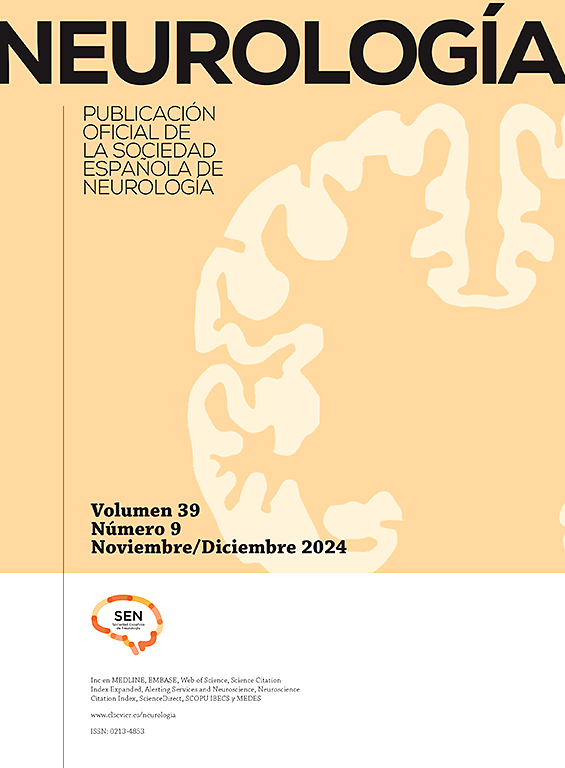重新定义西班牙队列中CACNA1S突变的周期性麻痹
IF 3.1
4区 医学
Q2 CLINICAL NEUROLOGY
引用次数: 0
摘要
据报道,肌肉MRI和电生理运动测试是低钾性周期性麻痹(HypoPP)的有用技术。患有这种疾病的男性和女性之间的显著临床差异是众所周知的;然而,关于在无症状人群中进行补充检测的信息很少。方法我们从4个独立的家族中招募了11例HypoPP患者,他们携带钙通道基因CACNA1S的p.R528H突变;样本包括8名有症状的男性和3名无症状的女性,以及来自同一家庭的9名对照组。在这一同质队列中评估肌肉MRI和电生理长时间运动测试结果。结果在有症状和无症状携带者中,肌肉MRI表现为萎缩和脂肪浸润,主要累及大腿后隔肌,首先累及大收肌和半膜肌,与年龄有关。长时间运动试验显示,无论症状如何,所有携带者的复合肌肉动作电位振幅和面积都有延迟性下降,35分钟后结果100%敏感。结论我们的研究结果重新定义了p.R528H CACNA1S突变引起的HypoPP的运动试验和肌肉成像结果,特别关注无症状携带者,他们表现出与有症状患者相同的改变,从而突出了它们作为筛查工具的价值。本文章由计算机程序翻译,如有差异,请以英文原文为准。
Redefining periodic paralysis with CACNA1S mutation in a Spanish cohort
Introduction
Muscle MRI and electrophysiological exercise testing have been reported as useful techniques in hypokalemic periodic paralysis (HypoPP). Striking clinical differences between men and women with this disorder are well known; however, little information is available on complementary tests in the asymptomatic population.
Methods
We recruited 11 individuals with HypoPP from 4 independent families, carrying the frequent p.R528H mutation in the calcium channel gene CACNA1S; the sample included 8 symptomatic men and 3 asymptomatic women, together with 9 controls recruited from the same families. Muscle MRI and electrophysiological long exercise test results were evaluated in this homogeneous cohort.
Results
Muscle MRI showed a consistent pattern of atrophy and fatty infiltration mainly involving posterior compartment muscles of the thigh, with first involvement of the adductor magnus and semimembranosus, both in symptomatic and all the asymptomatic carriers, associated with age. The long exercise test showed a delayed decrement in compound muscle action potential amplitude and area in all carriers, regardless of the symptoms, with results becoming 100% sensitive after 35 min.
Conclusions
Our findings redefine the exercise test and muscle imaging findings in HypoPP due to the p.R528H CACNA1S mutation, with a particular focus on asymptomatic carriers, who displayed the same alterations as those described in symptomatic patients, thus highlighting their value as screening tools.
求助全文
通过发布文献求助,成功后即可免费获取论文全文。
去求助
来源期刊

Neurologia
医学-临床神经学
CiteScore
5.90
自引率
2.60%
发文量
135
审稿时长
48 days
期刊介绍:
Neurología es la revista oficial de la Sociedad Española de Neurología y publica, desde 1986 contribuciones científicas en el campo de la neurología clínica y experimental. Los contenidos de Neurología abarcan desde la neuroepidemiología, la clínica neurológica, la gestión y asistencia neurológica y la terapéutica, a la investigación básica en neurociencias aplicada a la neurología. Las áreas temáticas de la revistas incluyen la neurologia infantil, la neuropsicología, la neurorehabilitación y la neurogeriatría. Los artículos publicados en Neurología siguen un proceso de revisión por doble ciego a fin de que los trabajos sean seleccionados atendiendo a su calidad, originalidad e interés y así estén sometidos a un proceso de mejora. El formato de artículos incluye Editoriales, Originales, Revisiones y Cartas al Editor, Neurología es el vehículo de información científica de reconocida calidad en profesionales interesados en la neurología que utilizan el español, como demuestra su inclusión en los más prestigiosos y selectivos índices bibliográficos del mundo.
 求助内容:
求助内容: 应助结果提醒方式:
应助结果提醒方式:


